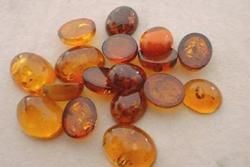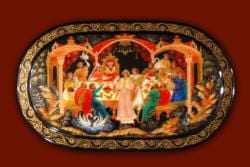Souvenirs
Most visitors to Russia are surprised by the amount of unique gifts and souvenirs, including quality handcrafts that they find themselves buying and taking home.
The easiest place to pick up matryoshki (the famous Russian nesting dolls), wooden toys, Soviet memorabilia such as badges and statues, and colourful Russian headscarves known as platki (singular is platok), is the souvenir market behind the Church of the Spilled Blood, on Konushennaya ploshchad. This is where a lot of the tourist excursion buses stop, so the quality may be fairly average and the goods over-priced. Be prepared to bargain if you see something you like. If you’re looking for military hats, belts, or other clothing, you could try the military stores (ÐоенÑоÑг) located a few hundred metres away on Griboedov canal towards Nevsky prospekt. The choice may be restricted, but prices will be more reasonable and the clothing genuine Russian army issue.
Lacquer boxes are another popular souvenir. These are small boxes painted black with colourful scenes from traditional Russian folk tales or religious subjects applied onto them. The most well known are from Palekh and Fedoskino and can cost several hundred euros for larger ones or those with particularly detailed paintings. Check the quality carefully before purchasing, as there are many which are now mass-produced.
The Soviet Union had a well-earned reputation for military engineering and precision mechanics, and Soviet watches were a by-word for reliable and rugged use. The famous Raketa brand, whose factory is located just outside St Petersburg in Peterhof, nearly went out of business in the 1990s, but has been revived by foreign investors and is once again producing innovative and stylish quality watches. A factory tour is a must for those particularly interested, but otherwise the range of Soviet-retro themed Raketa watches can be purchased in shops across the city or from their website.
Another unique local souvenir is a piece of porcelain from the Imperial Porcelain Factory. The original factory was founded in 1744 at the orders of Empress Elizabeth, the daughter of Peter the Great, and was only the third to be founded in the whole of Europe. Renamed the Lomonosov Porcelain Factory by the Soviets, the original name has now been restored and there are a number of shops throughout the city. The factory also organizes tours. Small pieces can be purchased for as little as a few hundred roubles and make a great gift or souvenir. Check out the website for full details.
It’s hard to spend any time in Russia during the winter without succumbing to fur envy. Russian women look so glamorous swishing around in their ankle-length fur coats that western notions of animal rights often fall by the wayside in the desire to look equally glamorous. Much of Russia’s early trading success lay in selling animal furs to wealthy Europeans, and fur coats and hats (usually non-endangered farmed animals such as mink or rabbit) for both sexes still make great (if expensive) gifts for loved ones or even oneself. There is absolutely no negative association with wearing fur in Russia as it is genuinely warmer than many synthetic materials, but bear in mind there may be fewer opportunities to wear that ankle-length mink coat once you get back to Europe, America or Australia!
The Baltic coast stretching the several hundred miles from the Russian enclave of Kaliningrad (formerly the Prussian city of Konigsberg), along the coasts of Lithuania, Latvia, Estonia and into Russia, is the world's greatest producer of amber. The fossilized tree resin has been traded here for at least 2000 years, and approximately 90% of the world's extractable amber is mined along this coast. This means that you'll find many trinkets, rings, necklaces and so on made from amber (with or wthout trapped prehistoric insects) in the souvenir shops of St Petersburg. Although not cheap, they are considerably cheaper here than in other parts of the world so you might want to use that as an excuse to buy a special present for a loved-one.
Be aware that there may be some restrictions on exporting or importing certain categories of souvenirs. Anything antique, including paintings, sculptures, icons and other religious artifacts, require an export permit to take out of the country. Antique stores should be able to assist with this so it’s best to purchase from a reputable dealer if this is what you’re looking for. Another popular souvenir, caviar is available from fine food stores and delicatessens and can cost hundreds of euros for even a small pot of top quality Caspian caviar. However at the other end of the scale, small tins are available in supermarkets for a couple of hundred roubles. In both cases check with your home country before attempting to import it as they could be confiscated by customs.

















